Robotics Market Size 2025-2029
The robotics market size is valued to increase USD 18.79 billion, at a CAGR of 6.1% from 2024 to 2029. Emergence of medical robotics will drive the robotics market.
Major Market Trends & Insights
- APAC dominated the market and accounted for a 57% growth during the forecast period.
- By Application - Industrial segment was valued at USD 31.98 billion in 2023
- By End-user - Manufacturing segment accounted for the largest market revenue share in 2023
Market Size & Forecast
- Market Opportunities: USD 53.99 million
- Market Future Opportunities: USD 18790.60 million
- CAGR : 6.1%
- APAC: Largest market in 2023
Market Summary
- The market represents a dynamic and continually evolving industry, driven by advancements in core technologies and applications. Key technologies, such as artificial intelligence, machine learning, and automation, are fueling the adoption of robots in various sectors, including manufacturing, healthcare, and logistics. According to recent reports, the market is expected to reach a significant market share by 2027, growing at a steady pace due to the increasing demand for automation and labor savings. Innovative business models, such as robotics-as-a-service and pay-per-use, are gaining traction, making robotics more accessible to businesses of all sizes. However, the market faces challenges, including the shortage of skilled personnel to design, build, and maintain robots, as well as regulatory hurdles and ethical concerns.
- One of the most promising areas of growth in the market is medical robotics, which is transforming healthcare delivery through minimally invasive surgeries, telemedicine, and robotic rehabilitation. The emergence of medical robotics is just one example of how robotics is revolutionizing industries and improving productivity, efficiency, and quality.
What will be the Size of the Robotics Market during the forecast period?
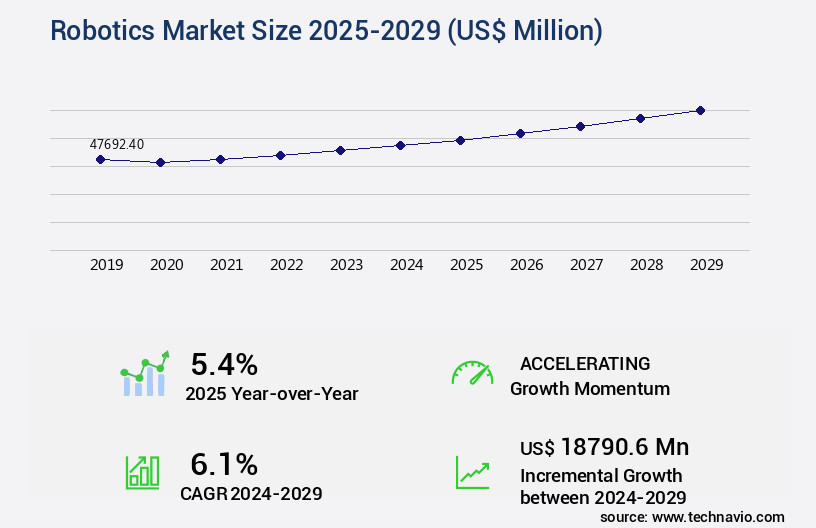
Get Key Insights on Market Forecast (PDF) Request Free Sample
How is the Robotics Market Segmented and what are the key trends of market segmentation?
The robotics industry research report provides comprehensive data (region-wise segment analysis), with forecasts and estimates in "USD million" for the period 2025-2029, as well as historical data from 2019-2023 for the following segments.
- Application
- End-user
- Manufacturing
- Healthcare
- Aerospace and Defense
- Media and entertainment
- Others
- Component
- Hardware
- Software
- Services
- Geography
- North America
- Europe
- APAC
- China
- India
- Japan
- South Korea
- Rest of World (ROW)
By Application Insights
The industrial segment is estimated to witness significant growth during the forecast period.
The market trends encompass the integration of advanced technologies such as human-robot interaction, sensor fusion, computer vision systems, and embedded systems. Three-dimensional sensor integration, robot manipulators, end-effectors, obstacle avoidance, and force control techniques are increasingly adopted for enhanced robot capabilities. AI-powered robotics, object recognition, deep learning algorithms, and image processing are pivotal in driving automation across industries. Industrial automation sectors, including surgical robot systems, robotic welding systems, and precision assembly robots, are experiencing significant growth. The market is witnessing a surge in robot safety standards, programming languages, and collaborative robot systems. Autonomous mobile robots, real-time operating systems, and power electronics are gaining traction due to their ability to optimize industrial processes.
Key market trends include the integration of kinematic modeling, haptic feedback systems, reinforcement learning, motion planning algorithms, and path planning. SLAM algorithms, machine learning models, and industrial robot arms are transforming manufacturing processes. The market is expected to expand significantly, with sectors like automotive, metals and machinery, and electrical and electronics leading the charge. Small and medium-sized enterprises (SMEs) in countries like India, Taiwan, the US, Canada, and Central and Eastern Europe are increasingly adopting robotics and automation technologies. The future holds immense potential for robotics, with manufacturers across industries embracing smart manufacturing techniques involving robotics, automation, AI, and cloud computing.
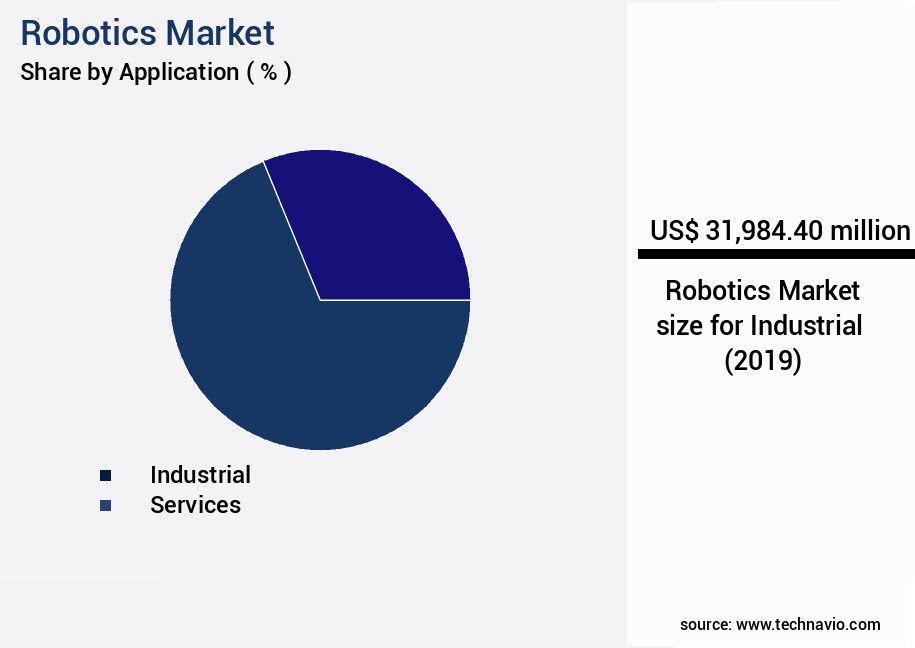
Request Free Sample
The Industrial segment was valued at USD 31.98 billion in 2019 and showed a gradual increase during the forecast period.
Approximately 25% of industrial companies have already adopted robotics, with expectations of over 30% of new industrial installations being automated in the next five years. Furthermore, the market is projected to grow by over 28% in the next decade, with significant growth in the automotive, metals and machinery, and electrical and electronics sectors. These trends underscore the continuous evolution and increasing importance of robotics in various industries.
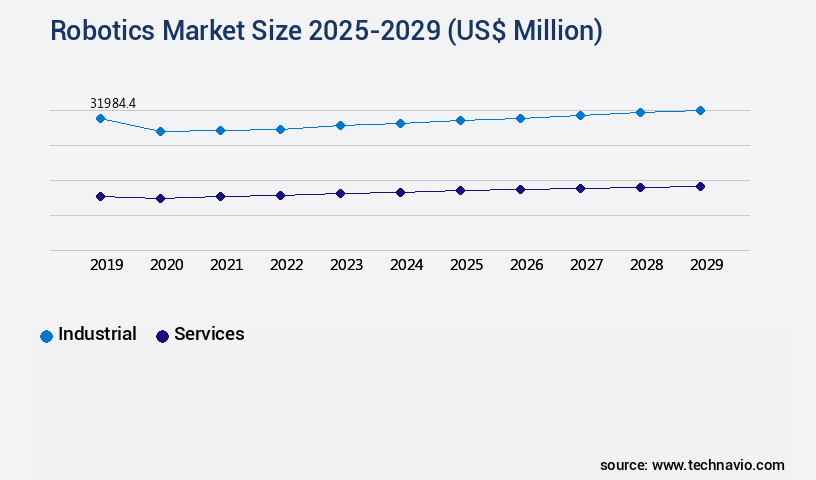
Request Free Sample
Regional Analysis
APAC is estimated to contribute 57% to the growth of the global market during the forecast period.Technavio's analysts have elaborately explained the regional trends and drivers that shape the market during the forecast period.
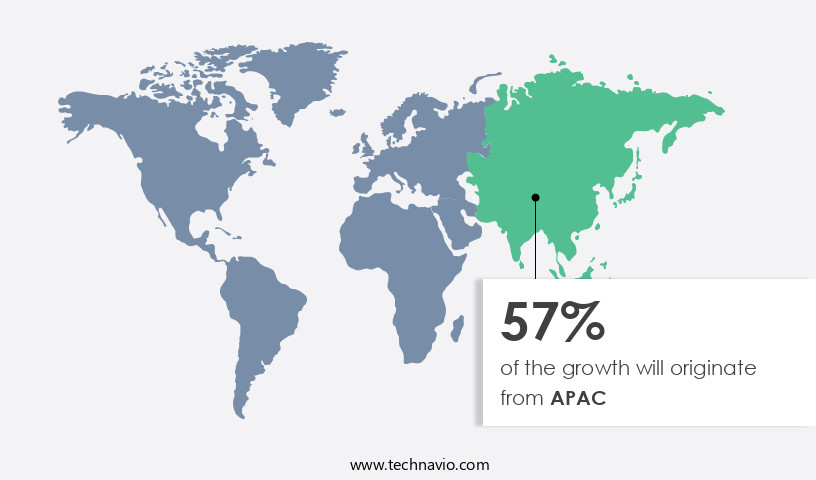
See How Robotics Market Demand is Rising in APAC Request Free Sample
In the dynamic landscape of the market, several influential factors are driving its expansion, particularly in the Asia Pacific (APAC) region. Government initiatives and the robust manufacturing sector serve as catalysts for market growth. Countries like China and India are witnessing significant investments from automotive manufacturers in automation solutions, enabling them to enhance productivity and reduce manufacturing cycles. This strategic move provides these players with a competitive edge in the industry. Key contributors to market expansion in APAC include China, India, Japan, and South Korea. The upcoming period is anticipated to witness a surge in demand for robots, as manufacturers adopt robotics and automation to mitigate challenges posed by outdated equipment, unstable production, and reliance on manual labor.
Market Dynamics
Our researchers analyzed the data with 2024 as the base year, along with the key drivers, trends, and challenges. A holistic analysis of drivers will help companies refine their marketing strategies to gain a competitive advantage.
The market encompasses a diverse range of advanced technologies and applications, driven by the relentless pursuit of precision, efficiency, and innovation. This dynamic industry is characterized by the integration of industrial robot systems, enabling seamless automation in manufacturing and production processes. Advanced robot control algorithms are at the heart of this transformation, optimizing performance and enhancing flexibility. Precision robotic assembly applications have gained significant traction, with computer vision for robotic manipulation playing a pivotal role in ensuring accuracy and consistency. Real-time sensor data fusion techniques and AI-driven robot learning capabilities further augment the capabilities of these systems, allowing for adaptive and responsive automation.
Haptic feedback in surgical robotics and autonomous mobile robot navigation systems are revolutionizing the healthcare and logistics sectors, respectively. Collaborative robot safety protocols facilitate human-robot interaction, paving the way for increased productivity and improved working conditions. The design and implementation of robotic systems continue to evolve, with kinematic modeling and dynamic simulation enabling sophisticated path planning for mobile manipulators. Object recognition for robotic picking and force control for delicate assembly tasks further expand the versatility of these systems. In the realm of programming, the open-source Robot Operating System (ROS) has emerged as a popular choice for robotics developers. The applications of deep learning in robotics and the development of intelligent robotic systems are pushing the boundaries of automation, while advanced sensor technologies for robotics ensure reliable and accurate data collection.
Notably, the industrial application segment accounts for a significantly larger share of the market compared to the academic segment. This disparity can be attributed to the pressing need for productivity gains and cost savings in industrial settings. Despite this, the academic sector continues to contribute valuable research and innovations that drive the overall growth of the market. In summary, the market is a thriving ecosystem of advanced technologies and applications, underpinned by a relentless drive for precision, efficiency, and innovation. The integration of AI, computer vision, and advanced sensor technologies is transforming industries, from manufacturing and healthcare to logistics and beyond.
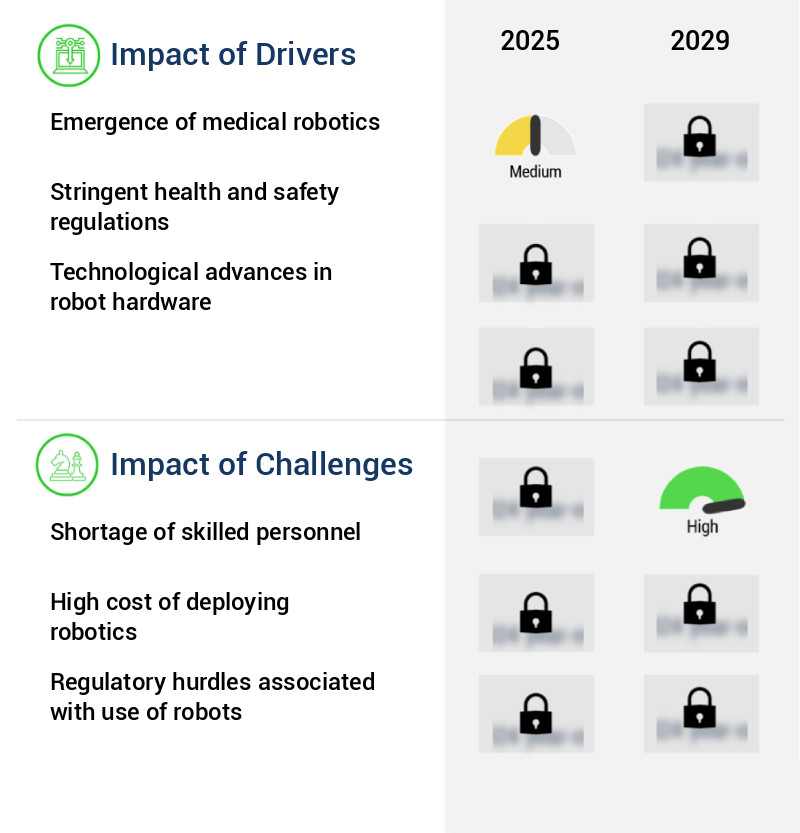
What are the key market drivers leading to the rise in the adoption of Robotics Industry?
- The emergence of medical robotics serves as the primary catalyst for market growth in this sector.
- The healthcare sector faces a critical workforce shortage, exacerbating the need for technological innovations such as medical robotics. The aging of caregivers and insufficient availability of medical professionals in both urban and rural areas contribute to this issue. In particular, hospitals and specialized medical facilities often struggle to maintain adequate staffing levels. This shortage results in missed care opportunities for patients, highlighting the importance of addressing this challenge. The global healthcare workforce deficit is particularly pronounced in countries like India, Pakistan, and China.
- Medical robotics, with its potential to augment human capabilities and improve patient outcomes, is gaining traction as a viable solution. The ongoing evolution of robotic surgery and diagnostics technologies continues to expand their applications across various healthcare sectors.
What are the market trends shaping the Robotics Industry?
- The adoption of innovative business models is becoming a mandatory trend in the market. Innovative business models are increasingly being embraced in the business world.
- Robotics as a Service (RaaS) represents a business model where robots are leased or rented to end-users on a monthly or hourly basis, accompanied by essential services such as upgradation and maintenance. This approach allows businesses to access advanced robotics technology without significant upfront investment. Additionally, the integration of cloud computing enhances offerings through real-time remote monitoring. The market is expected to expand, with more companies entering to provide RaaS solutions, maximizing product life and minimizing support costs. Improvements in remote diagnostics will further contribute to cost reduction and the decrease in onsite support requirements.
- This model's flexibility and cost savings make it an attractive solution for various industries, including manufacturing, healthcare, and logistics. The continuous advancements in robotics technology and the increasing demand for automation will drive the growth and evolution of the RaaS market.
What challenges does the Robotics Industry face during its growth?
- The lack of a sufficient workforce with necessary skills poses a significant obstacle to the expansion and progression of the industry.
- The market faces a significant challenge due to the workforce's insufficient technical expertise. End-users often hesitate to adopt robots due to the perceived downtime required for maintenance and servicing. This apprehension stems from the need for a deep understanding of robot functionality and servicing requirements. Companies in the robotics industry are addressing this issue by offering 24/7 remote support and cloud monitoring services. However, not all companies have adopted this trend. The lack of technical expertise among end-users continues to hinder the market's growth.
- Despite this challenge, the market demonstrates ongoing evolution and expansion across various sectors. The integration of advanced technologies, such as artificial intelligence and machine learning, is driving innovation and enhancing robot capabilities. This dynamic market continues to provide opportunities for businesses seeking to streamline operations and improve efficiency.
Exclusive Technavio Analysis on Customer Landscape
The robotics market forecasting report includes the adoption lifecycle of the market, covering from the innovator's stage to the laggard's stage. It focuses on adoption rates in different regions based on penetration. Furthermore, the robotics market report also includes key purchase criteria and drivers of price sensitivity to help companies evaluate and develop their market growth analysis strategies.
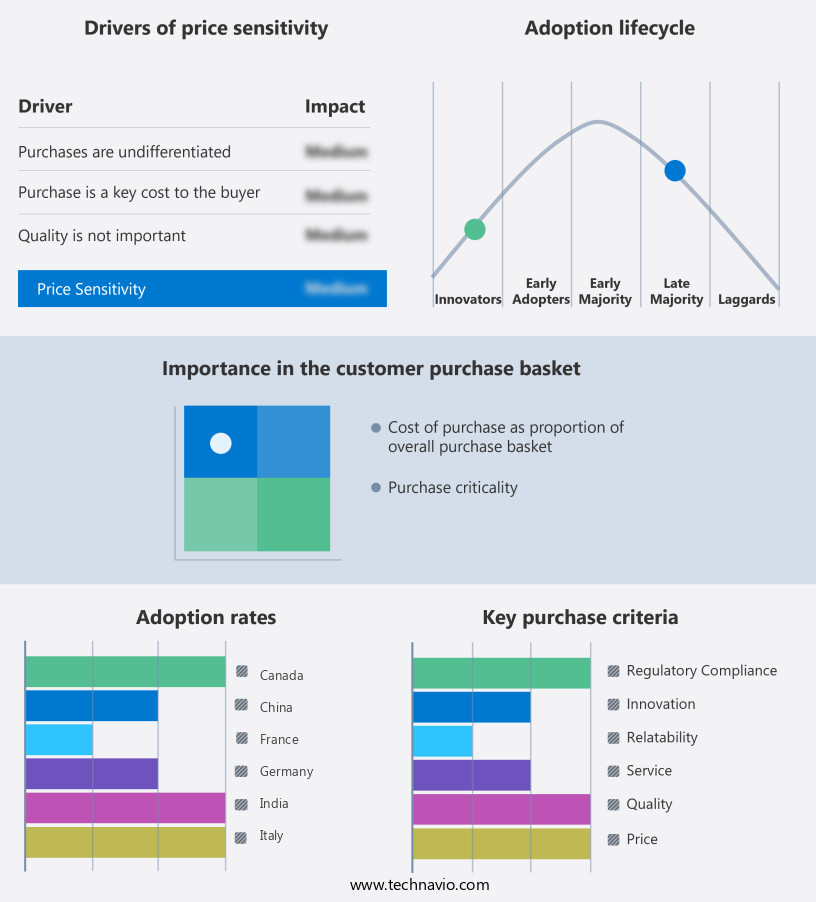
Customer Landscape of Robotics Industry
Competitive Landscape
Companies are implementing various strategies, such as strategic alliances, robotics market forecast, partnerships, mergers and acquisitions, geographical expansion, and product/service launches, to enhance their presence in the industry.
ABB Ltd. - This company specializes in robotics technology, providing innovative solutions through articulated and collaborative robots.
The industry research and growth report includes detailed analyses of the competitive landscape of the market and information about key companies, including:
- ABB Ltd.
- Clearpath Robotics Inc.
- Cyberdyne Inc.
- DENSO Corp.
- FANUC Corp.
- GEA Group AG
- Honeywell International Inc.
- Intuitive Surgical Inc.
- Irobot Corp.
- Kawasaki Heavy Industries Ltd.
- KION GROUP AG
- L3Harris Technologies Inc.
- Lely International NV
- MIDEA Group Co. Ltd.
- OMRON Corp.
- Relay Robotics Inc.
- SMP Robotics Systems Corp.
- Teradyne Inc.
- The Boeing Co.
- Zebra Technologies Corp.
Qualitative and quantitative analysis of companies has been conducted to help clients understand the wider business environment as well as the strengths and weaknesses of key industry players. Data is qualitatively analyzed to categorize companies as pure play, category-focused, industry-focused, and diversified; it is quantitatively analyzed to categorize companies as dominant, leading, strong, tentative, and weak.
Recent Development and News in Robotics Market
- In January 2024, ABB Robotics, a leading robotics company, announced the launch of its new collaborative robot, GoFaster, designed for high-mix, low-volume manufacturing environments. This innovative robot, featuring a 7th generation arm, is aimed at improving productivity and flexibility in various industries (ABB Press Release).
- In March 2024, Fanuc Corporation and Tesla, Inc. announced a strategic partnership to collaborate on the development and production of Tesla's next-generation electric vehicles. This collaboration marks a significant step in the automotive industry's adoption of advanced robotics technology (Fanuc Press Release).
- In May 2024, Softbank Robotics, a global leader in humanoid robotics, secured a USD 100 million Series E funding round led by Foxconn Technology Group. The investment will support the company's growth in the global market and the expansion of its Pepper and NAO robots' capabilities (Softbank Robotics Press Release).
- In January 2025, the European Union introduced the European Chips Act, a € 43 billion initiative aimed at boosting Europe's semiconductor industry and increasing its robotics manufacturing capabilities. The act includes funding for research, development, and production of advanced robotics systems (European Commission Press Release).
Dive into Technavio's robust research methodology, blending expert interviews, extensive data synthesis, and validated models for unparalleled Robotics Market insights. See full methodology.
|
Market Scope
|
|
Report Coverage
|
Details
|
|
Page number
|
0
|
|
Base year
|
2024
|
|
Historic period
|
2019-2023 |
|
Forecast period
|
2025-2029
|
|
Growth momentum & CAGR
|
Accelerate at a CAGR of 6.1%
|
|
Market growth 2025-2029
|
USD 18790.6 million
|
|
Market structure
|
Fragmented
|
|
YoY growth 2024-2025(%)
|
5.4
|
|
Key countries
|
US, China, Japan, India, Canada, South Korea, Germany, UK, Italy, and France
|
|
Competitive landscape
|
Leading Companies, Market Positioning of Companies, Competitive Strategies, and Industry Risks
|
Request Free Sample
Research Analyst Overview
- In the ever-evolving landscape of robotics, human-robot interaction continues to be a significant focus, with sensor fusion and computer vision systems playing crucial roles. Embedded systems, 3D sensor integration, and advanced robot manipulators are increasingly adopted to enhance robotic capabilities. Robot end-effectors, equipped with force control techniques and actuator control, facilitate precise manipulation of objects. AI-powered robotics, including object recognition through deep learning algorithms and image processing, are revolutionizing industries. Computer vision and SLAM algorithms enable robots to perceive and navigate their environments, while machine learning models optimize performance and adapt to new situations. Industrial automation, surgical robot systems, and robotic welding systems are among the sectors benefiting from these advancements.
- Kinematic modeling and precision assembly robots ensure efficient manufacturing processes, while robot safety standards and programming languages ensure reliable operation. Autonomous mobile robots, real-time operating systems, and collaborative robot systems are transforming logistics and production lines. Power electronics, haptic feedback systems, and reinforcement learning are further expanding the potential of robotics. Motion planning algorithms and path planning enable robots to navigate complex environments, while dynamic simulation facilitates testing and optimization. Overall, the market is characterized by continuous innovation, with each new development building upon the last, creating a dynamic and exciting industry.
What are the Key Data Covered in this Robotics Market Research and Growth Report?
-
What is the expected growth of the Robotics Market between 2025 and 2029?
-
What segmentation does the market report cover?
-
The report segmented by Application (Industrial and Services), End-user (Manufacturing, Healthcare, Aerospace and Defense, Media and entertainment, and Others), Component (Hardware, Software, and Services), and Geography (APAC, Europe, North America, Middle East and Africa, and South America)
-
Which regions are analyzed in the report?
-
APAC, Europe, North America, Middle East and Africa, and South America
-
What are the key growth drivers and market challenges?
-
Who are the major players in the Robotics Market?
-
Key Companies ABB Ltd., Clearpath Robotics Inc., Cyberdyne Inc., DENSO Corp., FANUC Corp., GEA Group AG, Honeywell International Inc., Intuitive Surgical Inc., Irobot Corp., Kawasaki Heavy Industries Ltd., KION GROUP AG, L3Harris Technologies Inc., Lely International NV, MIDEA Group Co. Ltd., OMRON Corp., Relay Robotics Inc., SMP Robotics Systems Corp., Teradyne Inc., The Boeing Co., and Zebra Technologies Corp.
Market Research Insights
- The market encompasses a diverse range of technologies and applications, including multi-robot systems, warehouse automation, rehabilitation robotics, and more. According to recent industry estimates, the global market for robotics is projected to reach USD 150 billion by 2025. This growth is driven by increasing demand for automation in manufacturing, logistics, healthcare, and other sectors. Robot safety and security are critical concerns in the market, with torque control and trajectory generation playing key roles in ensuring safe and efficient robot operation. For instance, wheeled robots in materials handling applications require precise torque control to prevent slippage and maintain stability.
- In contrast, legged robots in field robotics require sophisticated trajectory generation algorithms to navigate complex terrain. Another significant area of development in robotics is service robotics, which includes applications in healthcare, hospitality, and other sectors. According to a recent study, the global market for service robots is expected to reach USD 32.2 billion by 2025. This growth is attributed to the increasing demand for robots in tasks such as patient care, food service, and security. Despite these advancements, challenges remain in areas such as robot ethics, task planning, and manipulation tasks.
- Ongoing research in these areas is expected to drive further innovation and growth in the market.
We can help! Our analysts can customize this robotics market research report to meet your requirements.
Get in touch
1 Executive Summary
- 1.1 Market overview
- Executive Summary - Chart on Market Overview
- Executive Summary - Data Table on Market Overview
- Executive Summary - Chart on Global Market Characteristics
- Executive Summary - Chart on Market by Geography
- Executive Summary - Chart on Market Segmentation by Application
- Executive Summary - Chart on Market Segmentation by End-user
- Executive Summary - Chart on Market Segmentation by Component
- Executive Summary - Chart on Incremental Growth
- Executive Summary - Data Table on Incremental Growth
- Executive Summary - Chart on Company Market Positioning
2 Technavio Analysis
- 2.1 Analysis of price sensitivity, lifecycle, customer purchase basket, adoption rates, and purchase criteria
- Analysis of price sensitivity, lifecycle, customer purchase basket, adoption rates, and purchase criteria
- 2.2 Criticality of inputs and Factors of differentiation
- Overview on criticality of inputs and factors of differentiation
- 2.3 Factors of disruption
- Overview on factors of disruption
- 2.4 Impact of drivers and challenges
- Impact of drivers and challenges in 2024 and 2029
3 Market Landscape
- 3.1 Market ecosystem
- Parent Market
- Data Table on - Parent Market
- 3.2 Market characteristics
- Market characteristics analysis
4 Market Sizing
- 4.1 Market definition
- Offerings of companies included in the market definition
- 4.2 Market segment analysis
- 4.4 Market outlook: Forecast for 2024-2029
- Chart on Global - Market size and forecast 2024-2029 ($ million)
- Data Table on Global - Market size and forecast 2024-2029 ($ million)
- Chart on Global Market: Year-over-year growth 2024-2029 (%)
- Data Table on Global Market: Year-over-year growth 2024-2029 (%)
5 Historic Market Size
- 5.1 Global Robotics Market 2019 - 2023
- Historic Market Size - Data Table on Global Robotics Market 2019 - 2023 ($ million)
- 5.2 Application segment analysis 2019 - 2023
- Historic Market Size - Application Segment 2019 - 2023 ($ million)
- 5.3 End-user segment analysis 2019 - 2023
- Historic Market Size - End-user Segment 2019 - 2023 ($ million)
- 5.4 Component segment analysis 2019 - 2023
- Historic Market Size - Component Segment 2019 - 2023 ($ million)
- 5.5 Geography segment analysis 2019 - 2023
- Historic Market Size - Geography Segment 2019 - 2023 ($ million)
- 5.6 Country segment analysis 2019 - 2023
- Historic Market Size - Country Segment 2019 - 2023 ($ million)
6 Qualitative Analysis
- 6.1 Impact of AI on the Global Robotics Market
7 Five Forces Analysis
- 7.1 Five forces summary
- Five forces analysis - Comparison between 2024 and 2029
- 7.2 Bargaining power of buyers
- Bargaining power of buyers - Impact of key factors 2024 and 2029
- 7.3 Bargaining power of suppliers
- Bargaining power of suppliers - Impact of key factors in 2024 and 2029
- 7.4 Threat of new entrants
- Threat of new entrants - Impact of key factors in 2024 and 2029
- 7.5 Threat of substitutes
- Threat of substitutes - Impact of key factors in 2024 and 2029
- 7.6 Threat of rivalry
- Threat of rivalry - Impact of key factors in 2024 and 2029
- 7.7 Market condition
- Chart on Market condition - Five forces 2024 and 2029
8 Market Segmentation by Application
- 8.1 Market segments
- Chart on Application - Market share 2024-2029 (%)
- Data Table on Application - Market share 2024-2029 (%)
- 8.2 Comparison by Application
- Chart on Comparison by Application
- Data Table on Comparison by Application
- 8.3 Industrial - Market size and forecast 2024-2029
- Chart on Industrial - Market size and forecast 2024-2029 ($ million)
- Data Table on Industrial - Market size and forecast 2024-2029 ($ million)
- Chart on Industrial - Year-over-year growth 2024-2029 (%)
- Data Table on Industrial - Year-over-year growth 2024-2029 (%)
- 8.4 Services - Market size and forecast 2024-2029
- Chart on Services - Market size and forecast 2024-2029 ($ million)
- Data Table on Services - Market size and forecast 2024-2029 ($ million)
- Chart on Services - Year-over-year growth 2024-2029 (%)
- Data Table on Services - Year-over-year growth 2024-2029 (%)
- 8.5 Market opportunity by Application
- Market opportunity by Application ($ million)
- Data Table on Market opportunity by Application ($ million)
9 Market Segmentation by End-user
- 9.1 Market segments
- Chart on End-user - Market share 2024-2029 (%)
- Data Table on End-user - Market share 2024-2029 (%)
- 9.2 Comparison by End-user
- Chart on Comparison by End-user
- Data Table on Comparison by End-user
- 9.3 Manufacturing - Market size and forecast 2024-2029
- Chart on Manufacturing - Market size and forecast 2024-2029 ($ million)
- Data Table on Manufacturing - Market size and forecast 2024-2029 ($ million)
- Chart on Manufacturing - Year-over-year growth 2024-2029 (%)
- Data Table on Manufacturing - Year-over-year growth 2024-2029 (%)
- 9.4 Healthcare - Market size and forecast 2024-2029
- Chart on Healthcare - Market size and forecast 2024-2029 ($ million)
- Data Table on Healthcare - Market size and forecast 2024-2029 ($ million)
- Chart on Healthcare - Year-over-year growth 2024-2029 (%)
- Data Table on Healthcare - Year-over-year growth 2024-2029 (%)
- 9.5 Aerospace and Defense - Market size and forecast 2024-2029
- Chart on Aerospace and Defense - Market size and forecast 2024-2029 ($ million)
- Data Table on Aerospace and Defense - Market size and forecast 2024-2029 ($ million)
- Chart on Aerospace and Defense - Year-over-year growth 2024-2029 (%)
- Data Table on Aerospace and Defense - Year-over-year growth 2024-2029 (%)
- 9.6 Media and entertainment - Market size and forecast 2024-2029
- Chart on Media and entertainment - Market size and forecast 2024-2029 ($ million)
- Data Table on Media and entertainment - Market size and forecast 2024-2029 ($ million)
- Chart on Media and entertainment - Year-over-year growth 2024-2029 (%)
- Data Table on Media and entertainment - Year-over-year growth 2024-2029 (%)
- 9.7 Others - Market size and forecast 2024-2029
- Chart on Others - Market size and forecast 2024-2029 ($ million)
- Data Table on Others - Market size and forecast 2024-2029 ($ million)
- Chart on Others - Year-over-year growth 2024-2029 (%)
- Data Table on Others - Year-over-year growth 2024-2029 (%)
- 9.8 Market opportunity by End-user
- Market opportunity by End-user ($ million)
- Data Table on Market opportunity by End-user ($ million)
10 Market Segmentation by Component
- 10.1 Market segments
- Chart on Component - Market share 2024-2029 (%)
- Data Table on Component - Market share 2024-2029 (%)
- 10.2 Comparison by Component
- Chart on Comparison by Component
- Data Table on Comparison by Component
- 10.3 Hardware - Market size and forecast 2024-2029
- Chart on Hardware - Market size and forecast 2024-2029 ($ million)
- Data Table on Hardware - Market size and forecast 2024-2029 ($ million)
- Chart on Hardware - Year-over-year growth 2024-2029 (%)
- Data Table on Hardware - Year-over-year growth 2024-2029 (%)
- 10.4 Software - Market size and forecast 2024-2029
- Chart on Software - Market size and forecast 2024-2029 ($ million)
- Data Table on Software - Market size and forecast 2024-2029 ($ million)
- Chart on Software - Year-over-year growth 2024-2029 (%)
- Data Table on Software - Year-over-year growth 2024-2029 (%)
- 10.5 Services - Market size and forecast 2024-2029
- Chart on Services - Market size and forecast 2024-2029 ($ million)
- Data Table on Services - Market size and forecast 2024-2029 ($ million)
- Chart on Services - Year-over-year growth 2024-2029 (%)
- Data Table on Services - Year-over-year growth 2024-2029 (%)
- 10.6 Market opportunity by Component
- Market opportunity by Component ($ million)
- Data Table on Market opportunity by Component ($ million)
11 Customer Landscape
- 11.1 Customer landscape overview
- Analysis of price sensitivity, lifecycle, customer purchase basket, adoption rates, and purchase criteria
12 Geographic Landscape
- 12.1 Geographic segmentation
- Chart on Market share by geography 2024-2029 (%)
- Data Table on Market share by geography 2024-2029 (%)
- 12.2 Geographic comparison
- Chart on Geographic comparison
- Data Table on Geographic comparison
- 12.3 APAC - Market size and forecast 2024-2029
- Chart on APAC - Market size and forecast 2024-2029 ($ million)
- Data Table on APAC - Market size and forecast 2024-2029 ($ million)
- Chart on APAC - Year-over-year growth 2024-2029 (%)
- Data Table on APAC - Year-over-year growth 2024-2029 (%)
- 12.4 Europe - Market size and forecast 2024-2029
- Chart on Europe - Market size and forecast 2024-2029 ($ million)
- Data Table on Europe - Market size and forecast 2024-2029 ($ million)
- Chart on Europe - Year-over-year growth 2024-2029 (%)
- Data Table on Europe - Year-over-year growth 2024-2029 (%)
- 12.5 North America - Market size and forecast 2024-2029
- Chart on North America - Market size and forecast 2024-2029 ($ million)
- Data Table on North America - Market size and forecast 2024-2029 ($ million)
- Chart on North America - Year-over-year growth 2024-2029 (%)
- Data Table on North America - Year-over-year growth 2024-2029 (%)
- 12.6 Middle East and Africa - Market size and forecast 2024-2029
- Chart on Middle East and Africa - Market size and forecast 2024-2029 ($ million)
- Data Table on Middle East and Africa - Market size and forecast 2024-2029 ($ million)
- Chart on Middle East and Africa - Year-over-year growth 2024-2029 (%)
- Data Table on Middle East and Africa - Year-over-year growth 2024-2029 (%)
- 12.7 South America - Market size and forecast 2024-2029
- Chart on South America - Market size and forecast 2024-2029 ($ million)
- Data Table on South America - Market size and forecast 2024-2029 ($ million)
- Chart on South America - Year-over-year growth 2024-2029 (%)
- Data Table on South America - Year-over-year growth 2024-2029 (%)
- 12.8 US - Market size and forecast 2024-2029
- Chart on US - Market size and forecast 2024-2029 ($ million)
- Data Table on US - Market size and forecast 2024-2029 ($ million)
- Chart on US - Year-over-year growth 2024-2029 (%)
- Data Table on US - Year-over-year growth 2024-2029 (%)
- 12.9 China - Market size and forecast 2024-2029
- Chart on China - Market size and forecast 2024-2029 ($ million)
- Data Table on China - Market size and forecast 2024-2029 ($ million)
- Chart on China - Year-over-year growth 2024-2029 (%)
- Data Table on China - Year-over-year growth 2024-2029 (%)
- 12.10 Japan - Market size and forecast 2024-2029
- Chart on Japan - Market size and forecast 2024-2029 ($ million)
- Data Table on Japan - Market size and forecast 2024-2029 ($ million)
- Chart on Japan - Year-over-year growth 2024-2029 (%)
- Data Table on Japan - Year-over-year growth 2024-2029 (%)
- 12.11 India - Market size and forecast 2024-2029
- Chart on India - Market size and forecast 2024-2029 ($ million)
- Data Table on India - Market size and forecast 2024-2029 ($ million)
- Chart on India - Year-over-year growth 2024-2029 (%)
- Data Table on India - Year-over-year growth 2024-2029 (%)
- 12.12 Canada - Market size and forecast 2024-2029
- Chart on Canada - Market size and forecast 2024-2029 ($ million)
- Data Table on Canada - Market size and forecast 2024-2029 ($ million)
- Chart on Canada - Year-over-year growth 2024-2029 (%)
- Data Table on Canada - Year-over-year growth 2024-2029 (%)
- 12.13 UK - Market size and forecast 2024-2029
- Chart on UK - Market size and forecast 2024-2029 ($ million)
- Data Table on UK - Market size and forecast 2024-2029 ($ million)
- Chart on UK - Year-over-year growth 2024-2029 (%)
- Data Table on UK - Year-over-year growth 2024-2029 (%)
- 12.14 South Korea - Market size and forecast 2024-2029
- Chart on South Korea - Market size and forecast 2024-2029 ($ million)
- Data Table on South Korea - Market size and forecast 2024-2029 ($ million)
- Chart on South Korea - Year-over-year growth 2024-2029 (%)
- Data Table on South Korea - Year-over-year growth 2024-2029 (%)
- 12.15 Germany - Market size and forecast 2024-2029
- Chart on Germany - Market size and forecast 2024-2029 ($ million)
- Data Table on Germany - Market size and forecast 2024-2029 ($ million)
- Chart on Germany - Year-over-year growth 2024-2029 (%)
- Data Table on Germany - Year-over-year growth 2024-2029 (%)
- 12.16 France - Market size and forecast 2024-2029
- Chart on France - Market size and forecast 2024-2029 ($ million)
- Data Table on France - Market size and forecast 2024-2029 ($ million)
- Chart on France - Year-over-year growth 2024-2029 (%)
- Data Table on France - Year-over-year growth 2024-2029 (%)
- 12.17 Italy - Market size and forecast 2024-2029
- Chart on Italy - Market size and forecast 2024-2029 ($ million)
- Data Table on Italy - Market size and forecast 2024-2029 ($ million)
- Chart on Italy - Year-over-year growth 2024-2029 (%)
- Data Table on Italy - Year-over-year growth 2024-2029 (%)
- 12.18 Market opportunity by geography
- Market opportunity by geography ($ million)
- Data Tables on Market opportunity by geography ($ million)
13 Drivers, Challenges, and Opportunity/Restraints
- 13.3 Impact of drivers and challenges
- Impact of drivers and challenges in 2024 and 2029
- 13.4 Market opportunities/restraints
14 Competitive Landscape
- 14.2 Competitive Landscape
- Overview on criticality of inputs and factors of differentiation
- 14.3 Landscape disruption
- Overview on factors of disruption
- 14.4 Industry risks
- Impact of key risks on business
15 Competitive Analysis
- 15.2 Company ranking index
- 15.3 Market positioning of companies
- Matrix on companies position and classification
- 15.4 ABB Ltd.
- ABB Ltd. - Overview
- ABB Ltd. - Business segments
- ABB Ltd. - Key news
- ABB Ltd. - Key offerings
- ABB Ltd. - Segment focus
- SWOT
- 15.5 Clearpath Robotics Inc.
- Clearpath Robotics Inc. - Overview
- Clearpath Robotics Inc. - Product / Service
- Clearpath Robotics Inc. - Key news
- Clearpath Robotics Inc. - Key offerings
- SWOT
- 15.6 Cyberdyne Inc.
- Cyberdyne Inc. - Overview
- Cyberdyne Inc. - Product / Service
- Cyberdyne Inc. - Key offerings
- SWOT
- 15.7 DENSO Corp.
- DENSO Corp. - Overview
- DENSO Corp. - Business segments
- DENSO Corp. - Key news
- DENSO Corp. - Key offerings
- DENSO Corp. - Segment focus
- SWOT
- 15.8 FANUC Corp.
- FANUC Corp. - Overview
- FANUC Corp. - Product / Service
- FANUC Corp. - Key news
- FANUC Corp. - Key offerings
- SWOT
- 15.9 GEA Group AG
- GEA Group AG - Overview
- GEA Group AG - Business segments
- GEA Group AG - Key offerings
- GEA Group AG - Segment focus
- SWOT
- 15.10 Honeywell International Inc.
- Honeywell International Inc. - Overview
- Honeywell International Inc. - Business segments
- Honeywell International Inc. - Key news
- Honeywell International Inc. - Key offerings
- Honeywell International Inc. - Segment focus
- SWOT
- 15.11 Kawasaki Heavy Industries Ltd.
- Kawasaki Heavy Industries Ltd. - Overview
- Kawasaki Heavy Industries Ltd. - Business segments
- Kawasaki Heavy Industries Ltd. - Key news
- Kawasaki Heavy Industries Ltd. - Key offerings
- Kawasaki Heavy Industries Ltd. - Segment focus
- SWOT
- 15.12 KION GROUP AG
- KION GROUP AG - Overview
- KION GROUP AG - Business segments
- KION GROUP AG - Key news
- KION GROUP AG - Key offerings
- KION GROUP AG - Segment focus
- SWOT
- 15.13 L3Harris Technologies Inc.
- L3Harris Technologies Inc. - Overview
- L3Harris Technologies Inc. - Business segments
- L3Harris Technologies Inc. - Key news
- L3Harris Technologies Inc. - Key offerings
- L3Harris Technologies Inc. - Segment focus
- SWOT
- 15.14 Lely International NV
- Lely International NV - Overview
- Lely International NV - Product / Service
- Lely International NV - Key offerings
- SWOT
- 15.15 OMRON Corp.
- OMRON Corp. - Overview
- OMRON Corp. - Business segments
- OMRON Corp. - Key news
- OMRON Corp. - Key offerings
- OMRON Corp. - Segment focus
- SWOT
- 15.16 Relay Robotics Inc.
- Relay Robotics Inc. - Overview
- Relay Robotics Inc. - Product / Service
- Relay Robotics Inc. - Key offerings
- SWOT
- 15.17 SMP Robotics Systems Corp.
- SMP Robotics Systems Corp. - Overview
- SMP Robotics Systems Corp. - Product / Service
- SMP Robotics Systems Corp. - Key offerings
- SWOT
- 15.18 The Boeing Co.
- The Boeing Co. - Overview
- The Boeing Co. - Business segments
- The Boeing Co. - Key news
- The Boeing Co. - Key offerings
- The Boeing Co. - Segment focus
- SWOT
16 Appendix
- 16.2 Inclusions and exclusions checklist
- Inclusions checklist
- Exclusions checklist
- 16.3 Currency conversion rates for US$
- Currency conversion rates for US$
- 16.4 Research methodology
- 16.7 Validation techniques employed for market sizing
- Validation techniques employed for market sizing
- 16.9 360 degree market analysis
- 360 degree market analysis
- 16.10 List of abbreviations
- List of abbreviations
- o Technological advancements







![]() Get the report (PDF) sent to your email within minutes.
Get the report (PDF) sent to your email within minutes.
Complimentary full Excel data with your report purchase.